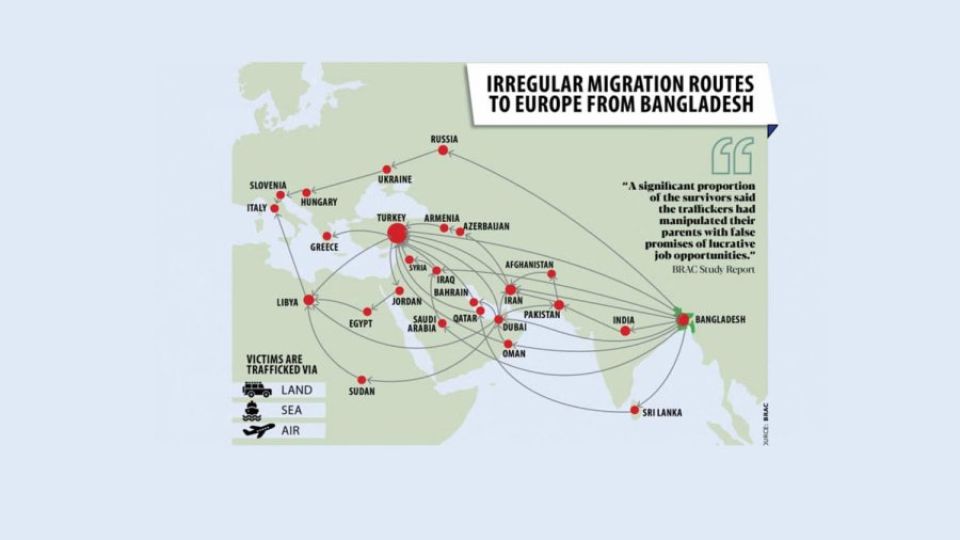February 23, 2024
DHAKA – An undocumented Bangladeshi migrant worker choosing to enter Europe from Libya, will almost certainly be held captive by armed militias, tortured, and their families extorted for lakhs of taka.
This is likely to happen even before the perilous boat journey across the Mediterranean, where hundreds perish every year.
As much as 63.2 percent of undocumented Bangladeshi migrant workers in Libya were forcibly held captive in torture camps by the traffickers at the North African state.
This was found by BRAC’s Migration Programme, which interviewed 629 survivors who were rescued and repatriated to Bangladesh in 2022. Of them, 557 were rescued from Libya alone. A large section of them intended to illegally migrate to Europe.
Libya is a key entry-point to Europe. Data shows that 93 percent were held captive in Libya by the “middlemen” or human smugglers who the migrants had entrusted their passages with.
About 78 percent of the survivors reported that they were physically tortured while 125 said they were given only one meal a day.
According to sources in the law enforcement agencies, migrant workers spend Tk 5-7 lakh for this passage to Europe. Out of this, Tk 2-3 lakh are taken before the trip and the rest is extorted when the workers are held captive in the detention camps.
The Counter Counter Terrorism and Transnational Crime (CTTC) unit of police previously identified a Libya-based Bangladeshi named Sharif Hossain as one of the traffickers in Libya. He has around 40 agents spread across Bangladesh who allure people with promises of a better life in Europe.
Most of the survivors interviewed by the BRAC researchers are from Faridpur, followed by Cumilla, and Noakhali. This gives an indication of where the trafficking rackets are more active.
“A significant proportion of the survivors said the traffickers had manipulated their parents with false promises of lucrative job opportunities,” reads the study.
Shajahan Hossain, additional SP (human trafficking) of CID, said, “We speak to everyone who comes back and encourage them to file cases and also give them legal assistance if needed. From the last two special flights from Libya carrying returnees, 25 expressed interest in filing cases … We can investigate only if there is a case.”
Tohidul Islam, additional deputy commissioner of police of Uttara Division said, “It is imperative that trafficked migrant workers file cases otherwise we cannot crack down on the rackets, and this cycle will continue.”
Since 2009, at least 26 lakh Bangladeshi migrants have migrated to Europe by sea, using the tip of northern Africa as a launching pad, says the BRAC study. An update by UNHCR from December 2023 found that of 5,236 refugees and migrants reached Italy by sea that month, 13 percent of them were Bangladeshis.
The research sheds light on the scale of horrors possibly faced by this large number of migrant workers.
However, it is not as if all migrants travel to Libya aiming to reach Europe. They often have no choice.
“Disturbingly, the study also highlighted that the vast majority of respondents (551) did not receive the promised job upon reaching their destinations, leaving them deceived and vulnerable. Only 36 respondents confirmed that they actually obtained the job as initially promised,” the study adds.
Out of the interviewed individuals, 316 paid for the dangerous journey themselves while 142 took money from their families but they all returned home penniless.
From 2016 to 2021, the number of people attempting to leave Libya by boat and being forced to return to the north African country rose from zero to over half of the people who made it across, said a report by Médecins Sans Frontières (MSF) released yesterday, adding, “In the first eight months of 2023, more than 11,000 people were intercepted at sea and returned to Libya.”
The MSF reported that the migrants they rescued all made multiple attempts to flee Libya by sea, some up to seven times.
Just over the past one year, 1,722 people were repatriated from Libya to Bangladesh on 12 special flights, according to airport and immigration data. On February 1, a plane brought in 136 rescued people.
Another special flight carrying 144 rescued Bangladeshis is scheduled to arrive in Dhaka today, announced the Embassy of Bangladesh in Libya.
The BRAC study says that the trafficking rings were abusing the tourist visa for Dubai. No matter which country they intend to traffic people to, Dubai is almost always a port of call.
The BRAC study found that most of the trafficked survivors went to Dubai from Dhaka, then Egypt, before landing in Libya.
Law enforcement sources claimed that a Pakistani smuggling ring operates chartered flights between Dubai and Libya
Other countries used as a transit between Dubai and Libya include Turkey, Sudan, Tunisia, Jordan, Syria and Kuwait, found the study. There are a total of 8 routes.
Dubai stopped issuing work permits for Bangladeshis in 2015.
Shariful Hasan, head of BRAC Migration Programme, said, “But there is a constant demand for Bangladeshi workers from companies in the Gulf state. All of them are given tourist visas. This means that they are not protected as formal migrant workers, and are susceptible to trafficking.”
Similarly, Libya and Bangladesh had no formal agreement about migrant workers until October last year, meaning human trafficking rings were the only means for migrants to reach the European gateway.
On February 15, a boat carrying 52 migrants caught fire and sank in the Mediterranean off Tunisian coast. Eight Bangladeshis perished in the accident, while 26 Bangladeshis were rescued. One Bangladeshi is critically injured and hospitalised.


